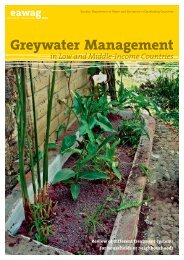Household Water Treatment and Safe Storage Factsheet: Source ...
Household Water Treatment and Safe Storage Factsheet: Source ...
Household Water Treatment and Safe Storage Factsheet: Source ...
You also want an ePaper? Increase the reach of your titles
YUMPU automatically turns print PDFs into web optimized ePapers that Google loves.
<strong>Household</strong> <strong>Water</strong> <strong>Treatment</strong> for Fluoride Removal<br />
<strong>Factsheet</strong>: Contact Precipitation<br />
Potential <strong>Treatment</strong> Capacity<br />
Very Effective For: Somewhat Effective For: Not Effective For:<br />
Fluoride<br />
Taste, odour, colour<br />
Other chemicals<br />
Turbidity<br />
Bacteria<br />
Viruses<br />
Protozoa<br />
Helminths<br />
Hardness<br />
What Is Contact Precipitation?<br />
Contact precipitation is a technique in which<br />
fluoride is removed from water through the<br />
addition of calcium <strong>and</strong> phosphate<br />
compounds, which leads to precipitation of<br />
fluoride. The water is then filtered through<br />
bone char that has been pre-saturated with<br />
fluoride.<br />
The process uses buckets, column filters or a<br />
combination. Different kinds of contact<br />
precipitation filters exist.<br />
before treatment to avoid the precipitation of<br />
calcium phosphate. It is advisable to check the<br />
bulk density as it may vary for different br<strong>and</strong>s.<br />
The most common calcium compounds used<br />
to react with the fluoride are either lime or<br />
calcium chloride (CC). This reacts with fluoride<br />
to form a precipitate (solid form) of calcium<br />
fluoride. A common phosphate compound<br />
used is sodium dihydrogenphosphate, also<br />
called monosodium phosphate or MSP.<br />
How Does It Remove Contamination?<br />
The precipitation of fluoride from water<br />
containing calcium <strong>and</strong> phosphate is<br />
theoretically possible, but in reality it is not<br />
feasible because the reactions are so slow.<br />
The addition of a compound like bone char is<br />
necessary to allow the precipitation of fluoride<br />
within a reasonable time. The saturated bone<br />
char helps with the removal of fluoride, <strong>and</strong><br />
filters out the precipitate. The contact time of<br />
the water in the filter with the compounds<br />
needs to be long enough to allow sufficient<br />
fluoride removal; however, if the contact time is<br />
too long, calcium ions may precipitate in the<br />
filter <strong>and</strong> fluoride removal efficiency will<br />
decrease. A 20 to 30 minute contact time is<br />
recommended.<br />
Operation<br />
<strong>Water</strong> is first treated with calcium <strong>and</strong><br />
phosphate compounds. Any calcium <strong>and</strong><br />
phosphate compounds can be used, but it is<br />
important to dissolve the chemicals prior to<br />
mixing them with the water. The chemicals are<br />
preferably prepared as two separate stock<br />
solutions <strong>and</strong> can be prepared once every<br />
month, but should not be mixed together<br />
Contact Precipitation Filter for <strong>Household</strong> Use<br />
(Credit: WHO, 2006)<br />
Long term operation of the contact<br />
precipitation technique in Tanzania has shown<br />
that the process functions effectively when the
















